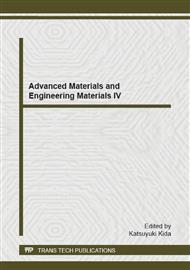[1]
C-Y. Lee, D-H. Choi, Y-M. Yeon, S-B. Jung, Dissimilar friction stir spot welding of low carbon steel and Al–Mg alloy by formation of IMCs, Science and Technology of Welding and Joining (2009), vol. 14, n. 3.
DOI: 10.1179/136217109x400439
Google Scholar
[2]
K. Nishimoto, H. Fujii1 and S. Katayama. Laser pressure welding of Al alloy and low C steel. Science and Technology of Welding and Joining. vol. 11, n. 2. (2006).
DOI: 10.1179/174329306x84300
Google Scholar
[3]
R. Borrisutthekul, T. Yachi, Y. Miyashita, Y. Mutoh. Suppression of intermetallic reaction layer formation by controlling heat flow in dissimilar joining of steel and aluminum alloy. Materials Science and Engineering A 467 (2007) 108–113.
DOI: 10.1016/j.msea.2007.03.049
Google Scholar
[4]
S. Satonaka, C. Iwamoto, R. Qui, Fujioka. Trends and new applications of spot welding for aluminum alloy sheets, Welding International. 858 — 864. (2006).
DOI: 10.1533/wint.2006.3677
Google Scholar
[5]
R. Qiu, C. Iwamoto, S. Satonaka. The influence of reaction layer on the strength of aluminum/steel joint welded by resistance spot welding. Materials Characterization, 60. 156–159. (2009).
DOI: 10.1016/j.matchar.2008.07.005
Google Scholar
[6]
X. Sun, E. V. Stephens, M. A. Khaleel, H. Shao, M. Kimchi. Resistance Spot Welding of Aluminum Alloy to Steel with Transition Material — From Process to Performance — Part I: Experimental Study. Welding Journal, June 2004. 188s - 195s.
Google Scholar
[7]
H. Oikawa, S. Ohmiya, T. Yoshimura, T. Saitoh. Resistance spot welding of steel and aluminum sheet using insert metal sheet. Science and Technology of Welding and Joining 1999 Vol. 4 No. 2.
DOI: 10.1179/136217199101537608
Google Scholar
[8]
R. Qiu, C. Iwamoto, S. Satonaka. Interfacial microstructure and strength of steel/aluminum alloy joints welded by resistance spot welding with cover plate. Journal of Materials Processing Technology 209 (2009) 4186–4193.
DOI: 10.1016/j.jmatprotec.2008.11.003
Google Scholar
[9]
H.T. Zhang, J.C. Feng, P. He, H. Hackl, Interfacial microstructure and mechanical properties of aluminum–zinc-coated steel joints made by a modified metal inert gas welding–brazing process, Materials Characterization 58 (2007) 588–592.
DOI: 10.1016/j.matchar.2006.07.008
Google Scholar
[10]
H.T. Zhang, J.C. Feng, P. He, B.B. Zhang, J.M. Chen, L. Wang. The arc characteristics and metal transfer behaviour of cold metal transfer and its use in joining aluminum to zinc-coated steel. Materials Science and Engineering A 499 (2009).
DOI: 10.1016/j.msea.2007.11.124
Google Scholar
[11]
M. Soltan Ali Nezhad, A. Haerian Ardakani. A study of joint quality of aluminum and low carbon steel strips by warm rolling. Materials and Design 30 (2009) 1103–1109.
DOI: 10.1016/j.matdes.2008.06.042
Google Scholar
[12]
W-B. Lee, M. Schmuecker, U.A. Mercardo, G. Biallas, S-B. Jung, Interfacial reaction in steel–aluminum joints made by friction stir welding, Scripta Materialia 55 (2006), 355–358.
DOI: 10.1016/j.scriptamat.2006.04.028
Google Scholar
[13]
S.D. Meshram, T. Mohandas, G. Madhusudhan Reddy. Friction welding of dissimilar pure metals. Journal of Materials Processing Technology 184 (2007) 330–337.
DOI: 10.1016/j.jmatprotec.2006.11.123
Google Scholar
[14]
T. -Y. Pan. Friction Stir Spot Welding (FSSW) – A Literature Review. SAE Technical Paper Series. 2007-01-1702.
DOI: 10.4271/2007-01-1702
Google Scholar
[15]
T. F. Kong, L. C. Chan, T. C. Lee, Qualitative study of bimetallic joints produced by solid state welding process, Science and Technology of Welding and Joining, 2008, vol. 13, nº 8.
DOI: 10.1179/174329308x383757
Google Scholar
[16]
C. Schilling, J.F. dos Santos, Patent Application, Az. 199 55737. 3-45.
Google Scholar
[17]
W.J. Arbegast, C. Allen, M. Langerman, F. Marquis, E. Henderson, C. Svedin, C. Moore, A. Trujillo, D. Podraza, J. Freeman, N. Koch, An Investigation of Friction Spot Welding of Thin Aluminum Sheets. 15th Advanced Aerospace Materials and Processes Conference and Exposition, Seattle USA, Jun 7-10 (2003).
Google Scholar
[18]
T.B. Kaspary, Preenchimento do furo remanescente em soldas por fricção com mistura mecânica de reparo em alumínio 6056-T4. Master degree thesis PPGEM-UFRGS, (2005).
Google Scholar
[19]
Z. Feng, M.L. Santella, S.A. David, R.J. Steel, M.S. Packer, T. Pan, M. Kuo, R.S. Bhatnagar, Friction Stir Spot Welding of Advanced High-Strength Steels – A Feasibility Study. SAE Paper 2005-01-1248.
DOI: 10.4271/2005-01-1248
Google Scholar
[20]
T. Rosendo, A.A.M. da Silva, M.A.D. Tier, F.D. Ramos, C.C.P. Mazzaferro, J.A.E. Mazzaferro, T.R. Strohaecker, J.F. dos Santos, Preliminary investigation on friction spot welding of alclad 2024 T3 aluminum alloy. XXXIII CONSOLDA – National Congress on Welding. Caxias do Sul, 27 – 30 de Agosto de (2007).
DOI: 10.4271/2007-01-3812
Google Scholar
[21]
A.A.M. da Silva, M.A.D. Tier, T.S. Rosendo, F.D. Ramos, C.C.P. Mazzaferro, J.A.E. Mazzaferro, T.R. Strohaecker, J.F. dos Santos, Performance Evaluation of 2-mm thick alclad AA2024 T3 Aluminum Alloy Friction Spot Welding. SAE AeroTech Congress Los Angeles, 17th – 20th September (2007).
DOI: 10.4271/2007-01-3812
Google Scholar
[22]
A.A.M. da Silva, J.F. dos Santos, T.S., Rosendo, F.D. Ramos, C.C.P. Mazzaferro, M. Beyer, M.A.D. Tier, L.A. Bergmann, J.A. E, Mazzaferro, T.R. Strohaecker, J.T. Isakovic. Microstructure and Properties of Friction Spot Welds in a 2-mm Thick Alclad AA2024 T3 Alloy. FABTECH International and AWS Welding Show, Chicago, IL, 11-14 November (2007).
DOI: 10.4271/2007-01-3812
Google Scholar
[23]
T. S. Rosendo, Estudo do desempenho mecânico de solda ponto por fricção (FSpW) da liga AA 6181-T4 por meio dos mecanismos de fratura sob solicitação de cisalhamento e de tração. PhD Thesis, PPGEM-UFRGS. (2009).
DOI: 10.11606/d.3.2022.tde-19012023-100812
Google Scholar
[24]
A. K. Lakshminarayanan, V. Balasubramanian, Process Parameters Optimization for Friction Stir Welding of RDE-40 Aluminum Alloy Using Taguchi Technique. Trans, Nonferrous Met, Soc, China. 18. 2008, 548 – 554.
DOI: 10.1016/s1003-6326(08)60096-5
Google Scholar
[25]
K. Panneerselvam, S. Aravindan, A. Gnanavelbabu, A. Noorul, Haq. Joining of Polymeric Matrix Composites. Journal of Materials Processing Technology. (2007).
DOI: 10.1016/j.jmatprotec.2007.11.016
Google Scholar
[26]
D. C. Montgomery, G. C. Runger, Applied Statistics and Probability for Engineers. 4th Edition. John Wiley & Sons. (2007).
Google Scholar


